Frequency-Dependent Schroeder Allpass Filters
Abstract
:1. Introduction
2. Schroeder Allpass Filters
2.1. Filter Operations
2.2. General Allpass Filters
2.3. Classic Schroeder Allpass
2.4. Gerzon’s Allpass
2.5. Dahl’s Absorbent Allpass
3. Proposed Frequency-Dependent Schroeder Allpass
3.1. Filter Structure
3.2. Poles and Group Delay
3.3. Example
4. Application in Decorrelation
5. Conclusions
Funding
Conflicts of Interest
References
- Schroeder, M.R.; Logan, B.F. “Colorless” artificial reverberation. IRE Trans. Audio 1961, AU-9, 209–214. [Google Scholar] [CrossRef]
- Välimäki, V.; Parker, J.D.; Savioja, L.; Smith, J.O., III; Abel, J.S. Fifty years of artificial reverberation. IEEE/ACM Trans. Audio Speech Lang. Process. 2012, 20, 1421–1448. [Google Scholar] [CrossRef]
- Abel, J.S.; Smith, J.O., III. Robust Design of Very High-Order Allpass Dispersion Filters. In Proceedings of the International Conference Digital Audio Effects (DAFx), Montreal, QC, Canada, 18–20 September 2006; pp. 13–18. [Google Scholar]
- Gardner, W.G. A real-time multichannel room simulator. J. Acoust. Soc. Am. 1992, 92, 1–23. [Google Scholar] [CrossRef]
- Gerzon, M.A. Unitary (energy-preserving) multichannel networks with feedback. Electron. Lett. 1976, 12, 278–279. [Google Scholar] [CrossRef]
- Poletti, M.A. A Unitary Reverberator For Reduced Colouration In Assisted Reverberation Systems. In Proceedings of the INTER-NOISE and NOISE-CON, Newport Beach, CA, USA, 10–12 July 1995; Volume 5, pp. 1223–1232. [Google Scholar]
- Schroeder, M.R. Natural Sounding Artificial Reverberation. J. Audio Eng. Soc. 1962, 10, 219–223. [Google Scholar]
- Moorer, J.A. About this reverberation business. Comput. Music J. 1979, 3, 13–17. [Google Scholar] [CrossRef]
- Väänänen, R.; Välimäki, V.; Huopaniemi, J.; Karjalainen, M. Efficient and Parametric Reverberator for Room Acoustics Modeling. In Proceedings of the International Computer Music Conference, Thessaloniki, Greece, 25–30 September 1997; pp. 200–203. [Google Scholar]
- Dattorro, J. Effect Design, Part 1: Reverberator and Other Filters. J. Audio Eng. Soc. 1997, 45, 660–684. [Google Scholar]
- Dahl, L.; Jot, J.M. A Reverberator based on Absorbent All-pass Filters. In Proceedings of the International Conference Digital Audio Effects (DAFx), Verona, Italy, 7–9 December 2000; pp. 1–6. [Google Scholar]
- Lokki, T.; Hiipakka, J. A time-variant reverberation algorithm for reverberation enhancement systems. In Proceedings of the International Conference Digital Audio Effects (DAFx), Limerick, Ireland, 6–8 December 2001; pp. 28–32. [Google Scholar]
- Schlecht, S.J.; Habets, E.A.P. Time-varying feedback matrices in feedback delay networks and their application in artificial reverberation. J. Acoust. Soc. Am. 2015, 138, 1389–1398. [Google Scholar] [CrossRef] [Green Version]
- Kendall, G.S. The Decorrelation of Audio Signals and Its Impact on Spatial Imagery. Comput. Music J. 1995, 19, 71. [Google Scholar] [CrossRef]
- Boueri, M.; Kyriakakis, C. Audio Signal Decorrelation Based on a Critical Band Approach. In Proceedings of the Audio Engineering Society Convention 117, San Francisco, CA, USA, 28–31 October 2004. [Google Scholar]
- Kermit-Canfield, E.; Abel, J.S. Signal Decorrelation Using Perceptually Informed Allpass Filters. In Proceedings of the International Conference Digital Audio Effects (DAFx), Brno, Czech Republic, 5–9 September 2016; pp. 225–231. [Google Scholar]
- Canfield-Dafilou, E.K.; Abel, J.S. A Group Delay-Based Method for Signal Decorrelation. In Proceedings of the Audio Engineering Society Convention 144, Milan, Italy, 23–26 May 2018. [Google Scholar]
- Poletti, M.A. The Stability Of Multichannel Sound Systems With Frequency Shifting. J. Acoust. Soc. Am. 2004, 116, 853–871. [Google Scholar] [CrossRef]
- Schlecht, S.J.; Habets, E.A.P. The stability of multichannel sound systems with time-varying mixing matrices. J. Acoust. Soc. Am. 2016, 140, 601–609. [Google Scholar] [CrossRef]
- Välimäki, V.; Parker, J.D.; Abel, J.S. Parametric Spring Reverberation Effect. J. Audio Eng. Soc. 2010, 58, 547–562. [Google Scholar]
- Jot, J.M.; Chaigne, A. Digital delay networks for designing artificial reverberators. In Proceedings of the Audio Engineering Society Convention, Paris, France, 19–22 February 1991; pp. 1–12. [Google Scholar]
- Abel, J.S.; Canfield-Dafilou, E.K. Dispersive Delay and Comb Filters Using a Modal Structure. IEEE Signal Process. Lett. 2019, 26, 1748–1752. [Google Scholar] [CrossRef]
- Alary, B.; Politis, A.; Välimäki, V. Velvet-Noise Decorrelator. In Proceedings of the International Conference Digital Audio Effects (DAFx), Edinburgh, UK, 5–9 September 2017; pp. 405–411. [Google Scholar]
- Schlecht, S.J.; Alary, B.; Välimäki, V.; Habets, E.A.P. Optimized velvet-noise decorrelator. In Proceedings of the International Conference Digital Audio Effects (DAFx), Aveiro, Portugal, 4–8 September 2018; pp. 1–8. [Google Scholar]
- Vilkamo, J.; Neugebauer, B.; Plogsties, J. Sparse Frequency-Domain Reverberator. J. Audio Eng. Soc. 2012, 59, 936–943. [Google Scholar]
- Välimäki, V.; Reiss, J.D. All About Audio Equalization: Solutions and Frontiers. Appl. Sci. 2016, 6, 129. [Google Scholar] [CrossRef] [Green Version]
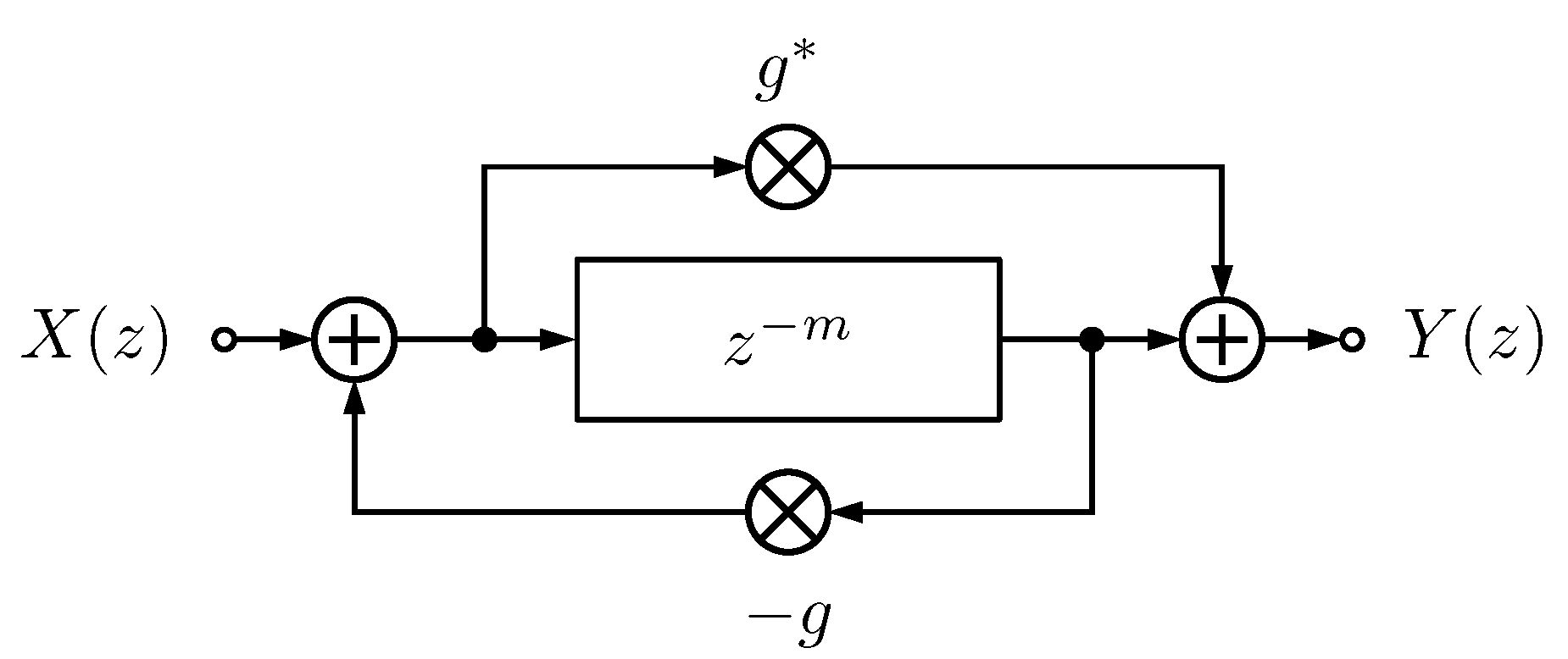


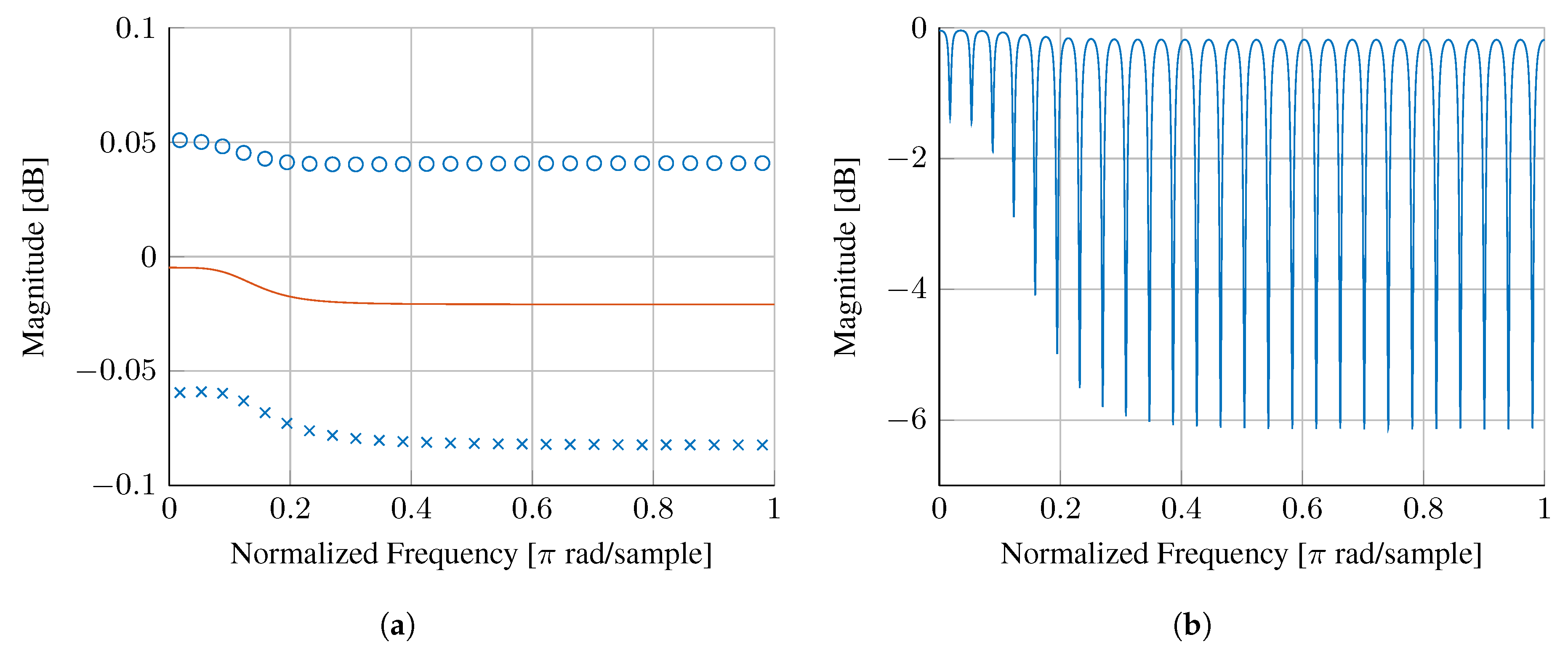
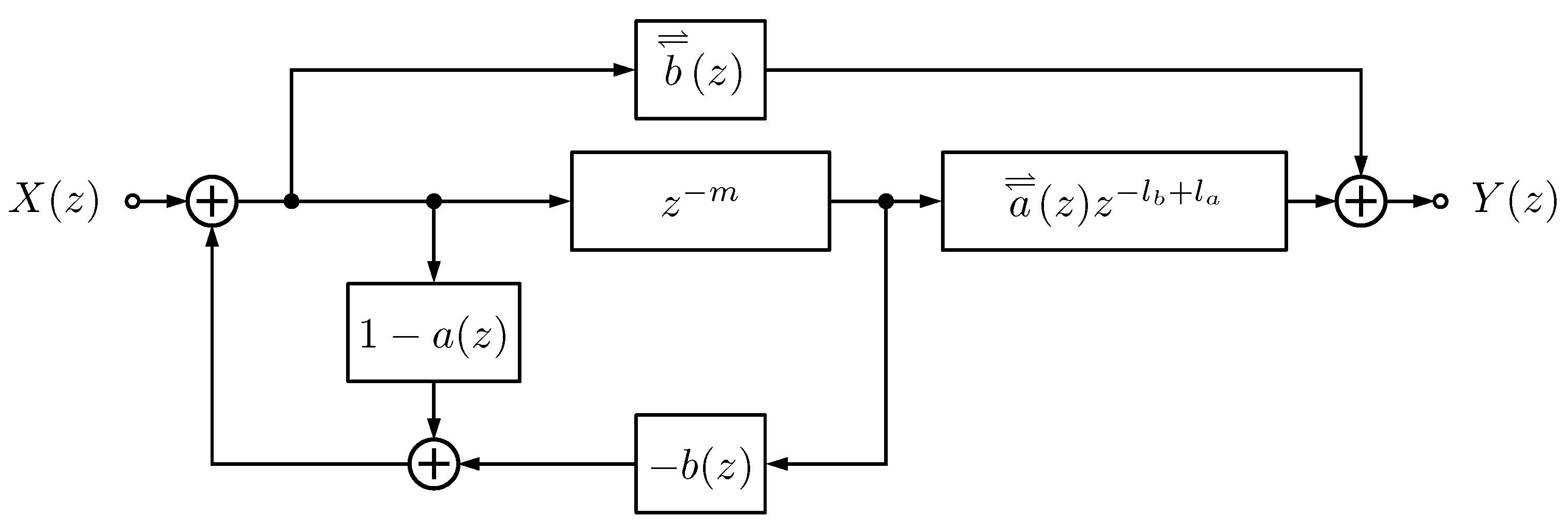


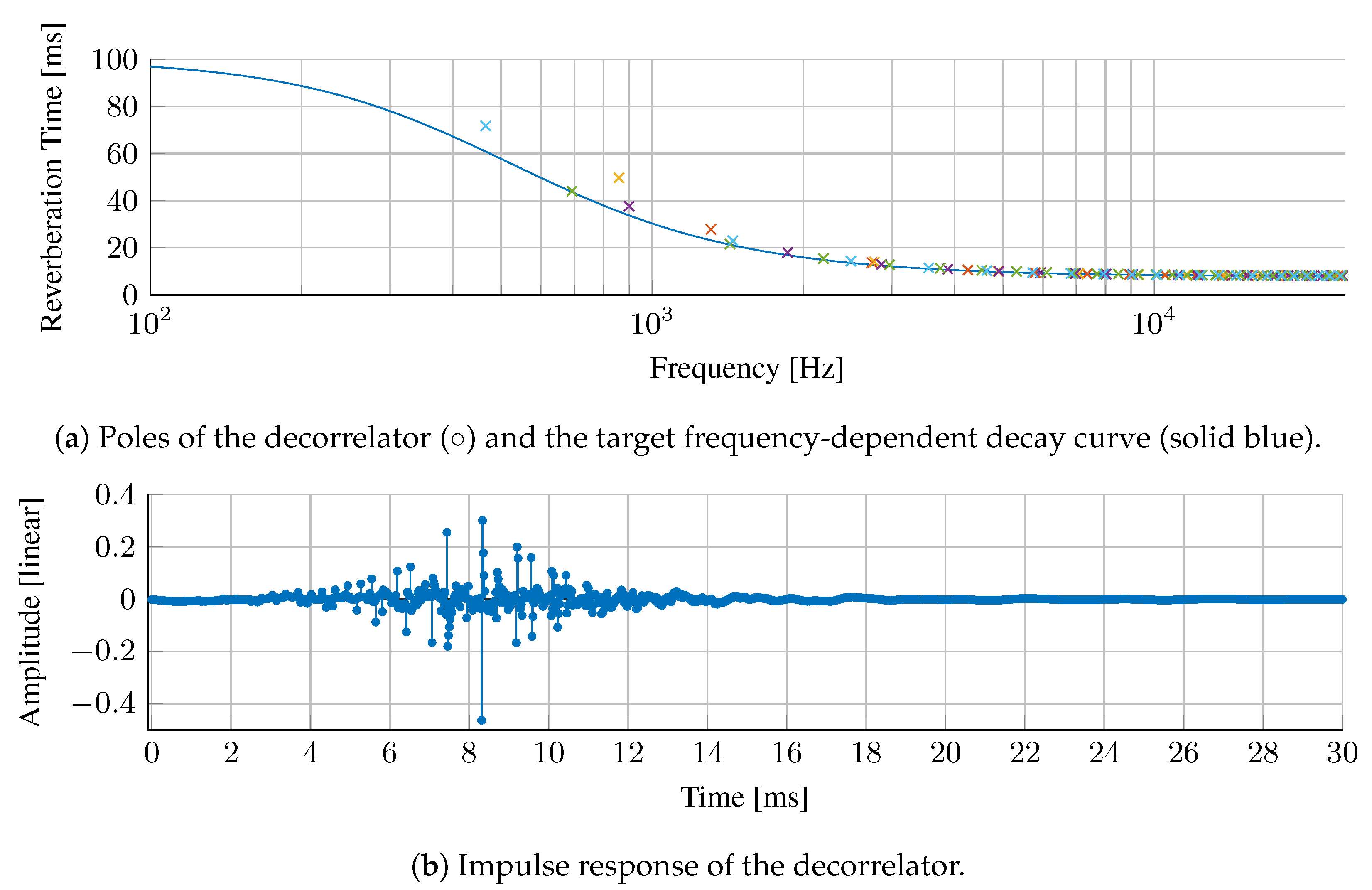
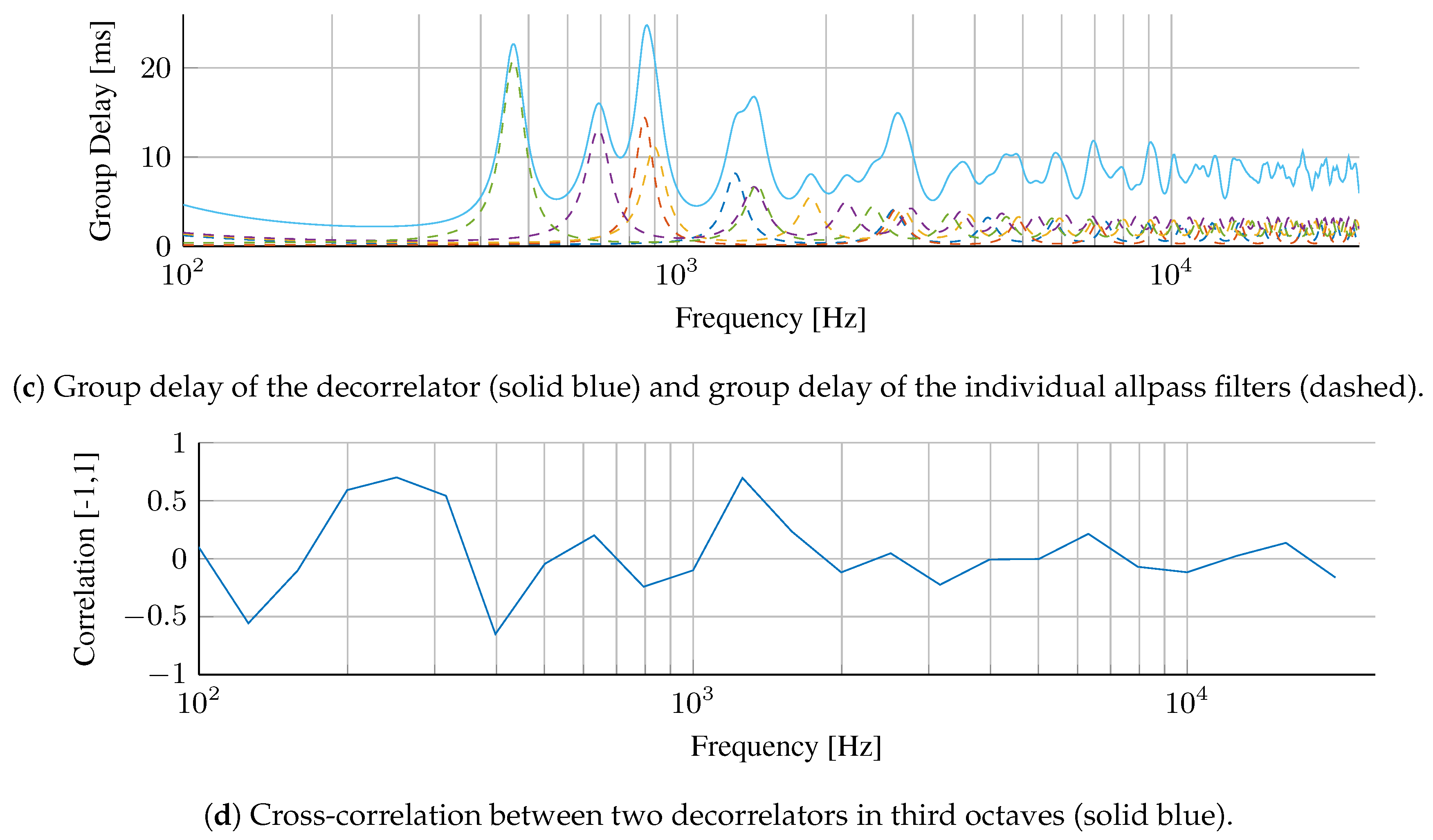
© 2019 by the author. Licensee MDPI, Basel, Switzerland. This article is an open access article distributed under the terms and conditions of the Creative Commons Attribution (CC BY) license (http://creativecommons.org/licenses/by/4.0/).
Share and Cite
Schlecht, S.J. Frequency-Dependent Schroeder Allpass Filters. Appl. Sci. 2020, 10, 187. https://doi.org/10.3390/app10010187
Schlecht SJ. Frequency-Dependent Schroeder Allpass Filters. Applied Sciences. 2020; 10(1):187. https://doi.org/10.3390/app10010187
Chicago/Turabian StyleSchlecht, Sebastian J. 2020. "Frequency-Dependent Schroeder Allpass Filters" Applied Sciences 10, no. 1: 187. https://doi.org/10.3390/app10010187
APA StyleSchlecht, S. J. (2020). Frequency-Dependent Schroeder Allpass Filters. Applied Sciences, 10(1), 187. https://doi.org/10.3390/app10010187




